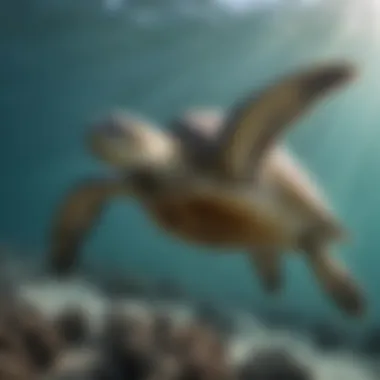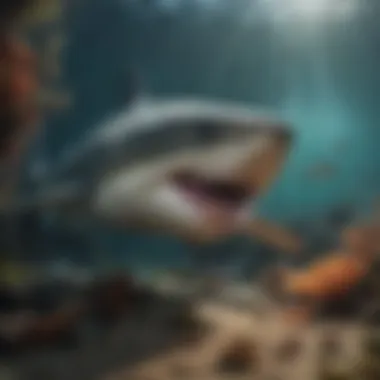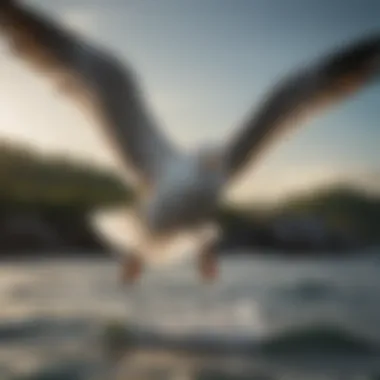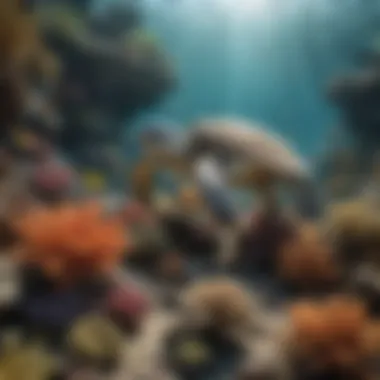Predators of the Green Sea Turtle: Ecological Insights


Intro
The green sea turtle, a majestic creature of the ocean, faces numerous threats to its survival. While humans are often viewed as a significant danger, it is crucial to consider the natural predators of these turtles within their ecosystems. Understanding these predators provides insight into the natural order and balance of marine life. As we delve deeper into the various species that prey upon the green sea turtle, from the moment they hatch on sandy beaches to their eventual maturity in open waters, we will explore their roles in the ecosystem and the implications for conservation.
Animal Overview
Common Name and Scientific Classification
The green sea turtle is scientifically recognized as Chelonia mydas. It belongs to the family Cheloniidae and is distinguished by its herbivorous diet, primarily consuming seagrasses and algae.
Physical Characteristics
Adult green sea turtles are known for their large, olive-green shells that can reach lengths of up to 4 feet. Their bodies are streamlined, allowing them to navigate efficiently through water. While their shells provide some protection, they are not impervious to predators. Hatchlings, in particular, are vulnerable due to their small size and soft bodies.
Habitat and Distribution
Green sea turtles inhabit warm coastal waters around the globe, primarily in tropical and subtropical regions. They are frequent residents of coral reefs, estuaries, and lagoons, where they find abundant food supply. Nesting often occurs on sandy beaches, making them susceptible to both terrestrial and marine predators.
Key Predators of Green Sea Turtles
Green sea turtles face various marine predators as well as threats from terrestrial species. Notable predators include:
- Sharks (such as the tiger shark): Known for their powerful jaws, sharks are adept hunters and can capture adult turtles.
- Large fish species (like barracudas and groupers): These predators often target young and weaker turtles.
- Seabirds: During the nesting season, birds may prey upon turtle eggs and hatchlings.
- Crabs: Land crabs can also become a significant threat, especially on nesting beaches.
Understanding the dynamics between these predators and green sea turtles is essential for marine conservation efforts.
Behavior and Social Structure
Communication Methods
Green sea turtles utilize various sounds and body movements during interactions, particularly during feeding or mating. These methods can be subtle and are still the subject of research among scientists.
Social Hierarchies
While not known for complex social structures like some other marine species, green sea turtles exhibit behaviors that suggest a level of social interaction, especially among nesting females.
Mating and Reproductive Behavior
Mating occurs during the warmer months, often near coastal areas where the females will return to nest. Females typically lay 100-200 eggs in one clutch, attempting to ensure the survival of their offspring despite numerous threats.
Conservation Status
Current Population Trends
The population of green sea turtles varies by region, with some areas showing signs of recovery due to conservation efforts. However, the overall global population remains vulnerable due to various threats.
Threats and Challenges
Human activities pose significant challenges, including habitat destruction, pollution, and poaching. Additionally, climate change impacts nesting sites and food availability.
Conservation Efforts and Success Stories
Numerous organizations are dedicated to the conservation of green sea turtles. Efforts include protecting nesting sites, reducing bycatch, and restoring seagrass habitats. Some populations have shown positive recovery trends owing to these initiatives.
Addressing the threats faced by these ancient mariners is crucial for not only their survival but also the broader health of marine ecosystems. By understanding their predators and the delicate balance they maintain within their environment, we can better appreciate the need for protective measures.
Prologue to Green Sea Turtles


Green sea turtles, known as Chelonia mydas, play a significant role in marine ecosystems. Their presence directly affects the health of sea grasses and coral reefs, proving their ecological importance. Understanding these turtles helps us appreciate the intricate relationships within their environment.
Ecological Significance
The ecological role of green sea turtles is vital. They are primarily herbivores, feeding on seagrasses and algae. This grazing behavior keeps seagrass beds healthy, promoting growth and promoting the stability of these underwater ecosystems. Moreover, their nesting activities contribute to the nutrient cycle, enriching the sandy beaches they use for laying eggs. This, in turn, supports various species that depend on these habitats.
In addition to this, green sea turtles are a food source for several predators within their ecosystem. Their life cycle and behaviors impact the distribution of marine life, showcasing the interconnectedness of species in the ocean. Green sea turtles also attract ecotourism, showing how enhanced conservation efforts can lead to economic benefits while promoting marine biodiversity.
Overview of Diet
Green sea turtles have a diet rich in vegetation. Their primary food sources include:
- Seagrasses
- Algae
- Marine plants
Unlike many marine turtles, green turtles are herbivores throughout most of their lives. This diet shifts when they are young, as they consume small invertebrates, but with age, they transition to primarily plant-based food. The selection of diet varies with geographical location and food availability. By digesting seagrass and other plant life, green sea turtles help maintain the health of marine ecosystems.
Understanding their diet is crucial for conservation efforts. Changes in habitats can impact food availability, which may affect their growth, reproduction, and survival. Therefore, protecting their food sources is a key aspect of ensuring the survival of green sea turtle populations.
Natural Predators of Green Sea Turtles
Understanding the natural predators of green sea turtles is essential for a comprehensive grasp of their life cycle and ecology. These predators play a significant role in the marine ecosystem and contribute to the complex interactions amongst various species. Since green sea turtles are vital for maintaining seagrass ecosystems, examining their natural threats helps in evaluating the health of marine environments.
Marine and land-based predators each have distinctive impacts on green sea turtles, affecting population dynamics and their reproductive success. By studying these interactions, researchers can identify conservation needs and strategies to protect this endangered species in their habitats.
Marine Predators
Sharks
Sharks are significant marine predators that often prey on green sea turtles. The presence of various shark species, such as the great white shark and tiger shark, illustrates their contribution to the predation network. Sharks are equipped with sharp teeth and excellent sensory abilities, enhancing their predatory skills. Their ability to detect vibrations and chemical signals in the water makes them efficient hunters, putting pressure on turtle populations.
Their key characteristic is their role as apex predators, maintaining the balance in marine ecosystems. This makes sharks beneficial in understanding the overall health of marine life. However, their status as a threat to green sea turtles underscores the need for conservation measures to protect both species in these environments.
Large Fish
Large fish, such as groupers and barracudas, also pose a threat to green sea turtles. These predatory fish primarily target juvenile turtles, which are especially vulnerable in open waters. Large fish are characterized by their significant size and speed, allowing them to ambush and consume turtles effectively.
Their impact on young turtle populations is critical, as high predation rates can severely hinder population recovery. By examining the predatory behaviors of large fish, we gain insight into the early life stage dangers and what is needed to support turtle populations during their vulnerable phases.
Orcas
Orcas, or killer whales, represent another serious threat to green sea turtles. Known for their intelligence and organized hunting techniques, orcas can coordinate their attacks to target turtles effectively. Their social structures facilitate complex predation strategies, making them capable hunters.
The key feature of orcas is their high adaptability in diverse habitats, allowing them to pursue turtles successfully. Their predation behavior raises important questions about the ecological balance, provoking new studies about the interactions between these powerful predators and their prey.
Land-Based Predators
Raccoons
Raccoons are notable land-based predators of green sea turtles, particularly in nesting areas. They are opportunistic feeders and often raid nests to consume eggs and hatchlings. Their ability to dig and use their dexterous paws makes them effective at accessing nests buried in sandy beaches.
The unique aspect of raccoons is their adaptability to coastal environments, which increases their interactions with turtle populations. Studying raccoon predation sheds light on the challenges faced by nesting turtles, emphasizing the need for protective measures to safeguard their eggs.
Birds
Birds, especially gulls and crows, also prey on turtle nests. They are quick and agile, often taking advantage of unguarded nests. Their predatory behavior significantly affects hatchling success rates.
The key characteristic of birds lies in their ability to cover large areas efficiently. This can drastically impact the reproductive success of green turtles. Understanding bird predation is crucial for devising strategies to improve hatchling survival rates.


Humans
Humans pose a significant threat to green sea turtles, including their eggs and nesting sites. Fishing practices, pollution, and coastal development lead to habitat destruction and increased mortality rates. Humans are unique as predators because their impact is often indirect, creating larger ecological consequences.
Their influence on turtle populations highlights the need for community awareness and conservation efforts. By understanding the human role in turtle predation, more effective strategies can be developed to mitigate threats and enhance the survival of this species.
The dynamics of predation reveal the challenges faced by green sea turtles and underscore the importance of protecting their habitats to ensure their continued existence.
Predatory Behavior and Techniques
Understanding the predatory behavior and techniques that threaten green sea turtles is crucial for grasping their ecological dynamics. Different predators deploy various strategies, ensuring their successful hunting and feeding. These techniques shape the survival of both the predators and the prey. It highlights the delicate balance in marine ecosystems and paints a clearer picture of how predation affects turtle populations and conservation efforts.
Shark Feeding Strategies
Sharks employ a range of feeding strategies to hunt green sea turtles. Some species, such as the great white shark and tiger shark, are known to patrol the waters where turtles migrate. Their speed and strength allow them to ambush turtles effectively.
- Ambush Tactics: Sharks often use stealth to approach their prey. They tend to lurk beneath the surface, using the elements of surprise in their favor. By blending in with their surroundings, they can attack when a turtle is least expecting.
- Pack Hunting: Larger sharks may hunt in groups. This coordination increases their chances of isolating and overpowering a turtle. They can cause distress and confusion, making it easier to strike.
- Biting Techniques: Some sharks may bite off pieces of the turtle instead of attempting to capture the whole animal. This tactic allows them to feed without expending significant energy.
These strategies are vital for the survival of shark species, underlining their role as apex predators in the marine hierarchy.
Ambush Predation by Orcas
Orcas, or killer whales, represent another significant threat to green sea turtles. Their hunting techniques vary based on group dynamics and environmental conditions.
- Strategic Hunting: Orcas are intelligent hunters. They often scout for turtles, using their sophisticated communication and teamwork. They can create a form of chaos to make turtles more vulnerable.
- Beach Stranding: In some cases, orcas exhibit a behavior called beaching. They partially come ashore to catch a turtle, utilizing their weight and force. This dramatic tactic can catch even the alertest turtle off guard.
- Targeting Weak Individuals: Orcas often prefer weak or sick turtles, making it essential to monitor overall turtle health within populations.
Orcas symbolize the complexity of predator-prey relationships, impacting turtle populations and highlighting the need for thorough research.
Nest Raiding by Terrestrial Predators
Nest raiding is a significant concern for green sea turtle hatchlings. Various terrestrial predators pose threats to eggs and newly hatched turtles.
- Raccoons: In some coastal areas, raccoons are known for raiding nests. They dig into sandy beaches to find eggs, which can decrease hatching success rates.
- Birds: Both gulls and crows target turtle nests, swooping down for easy access to eggs. Their keen eyesight allows them to find nests more effectively than other predators.
- Humans: Anthropogenic threats comprise a growing risk, where human activities infringe on turtle nesting sites. Illegal poaching and habitat destruction compound the dangers faced by these vulnerable species.
The predation on nests stresses the importance of conservation efforts. Successful nesting is critical for maintaining healthy populations of green sea turtles and ensuring they continue thriving in their natural habitats.
Impact of Predation on Green Sea Turtle Populations
Predation plays a significant role in the population dynamics and overall health of green sea turtle populations. Understanding this impact is crucial for conservation efforts and maintaining marine ecosystems. The intricate balance between predators and prey influences not only individual species but also the entire marine environment in which they interact.
Population Dynamics
The predation pressure on green sea turtles affects their population dynamics greatly. Predators such as sharks, orcas, and various large fish species are natural threats that can lead to varying mortality rates among different age classes of turtles. Juvenile green sea turtles are particularly vulnerable, as they often inhabit coastal waters where these predators are prevalent. A higher predation rate on younger turtles can result in slower population recovery, especially in areas where adult mortality is also high.
Population dynamics can also shift due to environmental factors, such as the availability of food resources and habitat conditions. For instance, if prey species decline, predators may shift their focus toward green sea turtles. This contributes to fluctuations in turtle numbers, potentially destabilizing local ecosystems.
Factors Influencing Population Dynamics
- Food Availability: A decrease in prey for predators may lead them to target green sea turtles more frequently.
- Habitat Loss: Urban development and pollution impact turtle nesting sites and feeding areas, intensifying predation risks.
- Climate Change: Changes in ocean temperatures and currents can affect both turtle habitats and predator distributions.
Reproductive Challenges
The impact of predators extends beyond mere population numbers; it poses substantial reproductive challenges for green sea turtles. Female turtles typically lay dozens to hundreds of eggs in a single nesting season, yet nest predation significantly reduces hatchling success rates. Species such as raccoons and certain birds often raid nests, consuming eggs before they can hatch.
In addition, the timing of nesting plays a role in reproductive success. If turtles nest too early or late in the season, hatchlings might face increased predation risks when emerging. The vulnerability of hatchlings during this phase is critical, as they must navigate a gauntlet of threats in both terrestrial and marine environments.
Implications for Reproductive Success


- Nest Location: Poor nest site selection can lead to increased exposure to predators.
- Predation Rates: The presence of predators in nesting areas directly correlates with hatchling survival rates.
- Human Interference: Activities such as beach development can increase predation risk by disturbing natural habitats.
The vulnerability of green sea turtle populations to predation highlights the need for targeted conservation efforts, particularly focusing on reducing nest predation and protecting critical habitats.
In summary, predation has a multifaceted impact on green sea turtle populations. By understanding the dynamics involved, conservationists and researchers can formulate effective strategies to enhance the survival and reproductive success of these marine reptiles.
Conservation Considerations
Conservation efforts for green sea turtles are crucial. Their populations face numerous threats, which can be exacerbated by predation. Protecting these species is not only about preserving their numbers but also maintaining the ecosystem balance. Green sea turtles play significant roles in marine and coastal environments. They help maintain seagrass beds, benefiting various marine organisms.
Protective Measures for Eggs and Hatchlings
Protecting eggs and hatchlings of green sea turtles requires targeted strategies. Beach habitats must be monitored to prevent nest predation. This can involve creating physical barriers around nesting sites. For example, mesh fencing can deter land-based predators like raccoons and birds from accessing the nests. Additionally, community involvement is vital. Local families can participate in nesting surveys, gaining awareness and helping count nests.
Efforts also need to be broad-scope. Education about the importance of these turtles should be provided in schools and community centers. This fosters a sense of responsibility among locals. Furthermore, all stakeholders should work together. Conservationists, policymakers, and residents must align their efforts. This could involve establishing protected areas where nesting occurs. Increased surveillance and a proactive approach can lead to better outcomes for hatchling survival rates.
Mitigating Human Impact
Human activities are a significant threat to green sea turtle populations. Beach development, pollution, and fishing practices contribute to the decline of these turtles. To mitigate these impacts, stricter regulations on coastal development are necessary. Conservation organizations advocate for sustainable practices in fisheries. Implementing guidelines can help minimize accidental catch, or bycatch, and protect marine habitats.
Another concern is plastic pollution. Education campaigns about reducing plastic use could have significant effects. Communities can organize clean-up events. These initiatives not only clear beaches but also raise awareness about marine conservation.
Effective legislation plays a pivotal role. Governments need to establish and enforce laws protecting turtles and their habitats. Cooperation between nations is equally important, as turtles often migrate across international waters. International agreements may aid in conserving these species globally.
Preserving green sea turtles is a shared responsibility that requires action at both local and global levels.
Cultural and Symbolic Meanings
Understanding the cultural and symbolic meanings of green sea turtles adds a rich layer to our appreciation of these creatures. In many cultures, turtles hold significant symbolism. They represent longevity, resilience, and wisdom. By exploring these meanings, we not only acknowledge their ecological importance but also their role in human storytelling and beliefs.
Turtles in Folklore
Across the globe, green sea turtles feature prominently in folklore. Many indigenous cultures regard them as sacred. For example, in certain Pacific Islander traditions, they are seen as guides or guardians of the ocean. Their long lives and migrations inspire tales of adventure and survival. In some stories, turtles are depicted as heroic figures, using their strength to help others or meet challenges.
Such narratives often emphasize the interconnectedness of life. They remind us that turtles, like other species, play a valued role in the ecosystem. Furthermore, these stories strengthen community ties, as they are shared across generations. By understanding how folklore incorporates green sea turtles, we can appreciate how cultural values and environmental awareness intersect.
Modern-Day Representation
In the modern era, green sea turtles are represented in various forms of media. Documentaries, films, and children's books commonly feature them. These representations help raise awareness about their plight and encourage conservation efforts. The symbolism remains potent; turtles are often associated with themes of ecology and respect for nature.
Moreover, these representations serve as educational tools. They inform audiences about the challenges turtles face, including predation and habitat loss. The visual appeal of these creatures can inspire activism and promote protective measures in local communities.
The importance of protecting green sea turtles transcends ecological concerns, as they embody deep-rooted cultural narratives that remind us of our shared responsibility to nature.
Ending
The examination of the natural threats to green sea turtles provides critical insights into their survival and the marine ecosystems they inhabit. Understanding the various predators that target these turtles is essential for evaluating not just their species' dynamics but also the broader ecological impacts. The interactions between green sea turtles and their predators illustrate a complex web of relationships that shapes marine life.
Summarizing Threats
Overall, several key threats to green sea turtles emerge from this discussion. These include:
- Marine predators such as sharks, large fish, and orcas that actively hunt adult turtles.
- Land-based threats from raccoons and birds, particularly targeting eggs in nesting grounds.
- Human impacts including habitat destruction, pollution, and illegal hunting which exacerbate these natural threats.
These factors collectively influence green sea turtle populations, often leading to reduced numbers and threatening the integrity of marine ecosystems. The consequences of these interactions highlight the delicate balance required for maintaining healthy oceanic environments.
Call for Continued Research and Protection
Emphasizing the need for further research is vital for the ongoing protection of green sea turtles. Continuous monitoring of predator-prey dynamics can offer valuable data to guide conservation efforts. Specific recommendations for future initiatives include:
- Establishing protected areas where nesting sites of green sea turtles are safeguarded from terrestrial predators and human interference.
- Enhancing public awareness on the threats faced by green sea turtles and their ecological significance. This can foster support for conservation programs.
- Investing in research focused on the impact of climate change on turtle habitats and predator populations.
The interplay of predation with other environmental factors signifies the need for a comprehensive approach to conservation. Academic, governmental, and non-profit organizations must collaborate to devise strategies that protect not only the green sea turtles but also the broader ecosystem they represent. Continued effort in research and sustainable practices is key to ensuring these ancient mariners thrive in their natural habitats.







